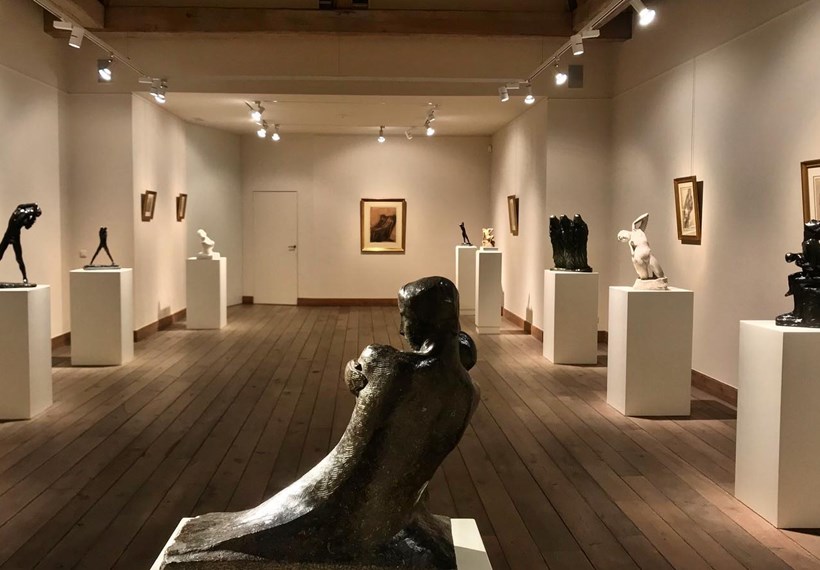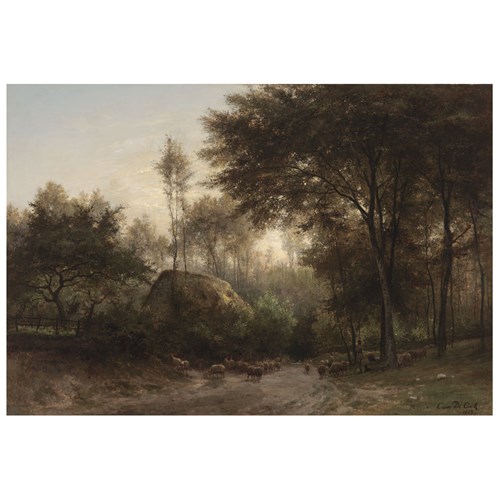Emile Claus
Sun effect on the Thames
Date 1918
Epoque 1910-1920, 1910s, First World War, WWI
Origine Gallery
Medium Oil on canvas
Dimension 61 x 50.5 cm (24⁰/₁ x 19⁷/₈ inches)
Dimension avec cadre 78.5 x 68 cm (30⁷/₈ x 26³/₄ inches)
"When Claus writes these rules, his London work takes on a definitive form. The artist has his own reality in mind and seeks a more realistic guidance in the depiction of the busy and noisy life on and around the stream. This Zonseffect on the Thames is one of the best realizations of Claus' series Réverbérations sur la Tamise. The Waterloo Bridge is shrouded in the hazy light of the evening sun. The perspective has been smothered by fog; only vaguely are the contours of the bridge visible to road traffic. The busy activities on and on the banks of the stream have been reduced to nothing at this evening: some vehicles on Embankment, Waterloo Bridge and the Thames are shown in the red evening light. Everything is concentrated around the solar effect on the water that reflects just behind and especially in front of the arches of the bridge, which at the same time puts perspective into the work. The painting is a highly personal impression of the farmer who settled down as a refugee in the metropolis, a city that led him to special impressions for the last time in his career.
Date: 1918
Epoque: 1910-1920, 1910s, First World War, WWI
Origine: Gallery
Medium: Oil on canvas
Signature: Signed and dated lower left: E. Claus / Londen / 1918
Dimension: 61 x 50.5 cm (24⁰/₁ x 19⁷/₈ inches)
Literature: - Claus, E., "The Thames from my Tower Windows," in: The Studio. An illustrated magazine of fine and applied art, vol 70 (London: The Studio, 1917), p. 169-179.
- De Smet, F., Gand Artistique, no. 4, 1923, p. 85-99.
- Sauton, A., Un Prince du Luminisme Emile Claus (Bruxelles: J. Lebègue & Cie, 1946), p. 54.
- Boyens, P., Sint-Martens-Latem. Kunstenaarsdorp in Vlaanderen (Tielt/ Sint-Martens-Latem: Lannoo/ Art Book Company, 1992), p. 540 (ill.).
- De Smet, J., Retrospectief Emile Claus, tent.cat. (Gent: SD&Z, 1997), pp. 56-58, 221.
- De Smet, J., Sint-Martens-Latem en de Kunst aan de Leie (1870-1970) (Tielt/Sint-Martens-Latem: Lannoo/ Art Book Company, 2000), p. 57-81.
- De Smet, J., A. Tomita, A. Yuzuhana e.a., Emile Claus and Belgian Impressionism (Japan: Himeji City Museum of Art, Tokyo Station Gallery, Ishikawa Prefectural Museum of Art & Hekinan City Tatsukichi Fujii Museum of Contemporary Art, 2013), p. 72-73, no. 26 (ill.).
- Pauwels, P.J.H., Als een fonkelenden spiegel (Sint-Martens-Latem: Galerie Oscar De Vos, 2019), p. 169 (ill.).
Plus d'œuvres d'art de la Galerie









_T638774556496745447.jpg?width=500&height=500&mode=pad&scale=both&qlt=90&format=jpg)